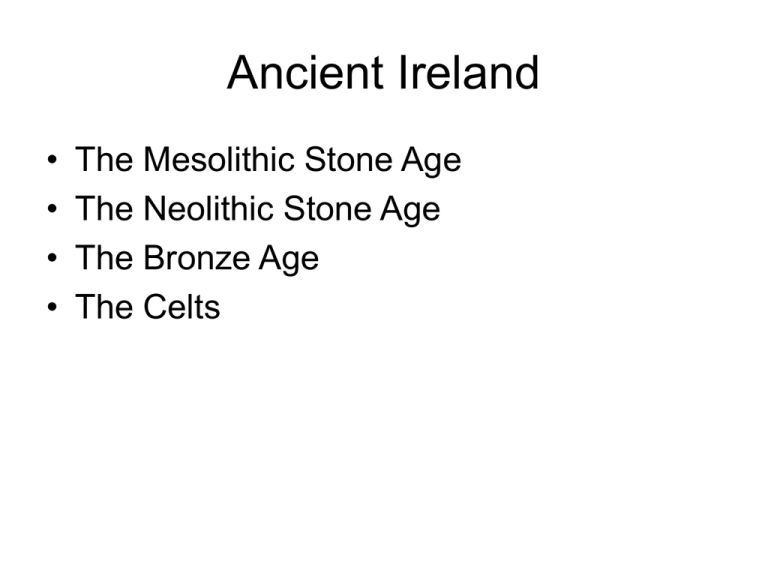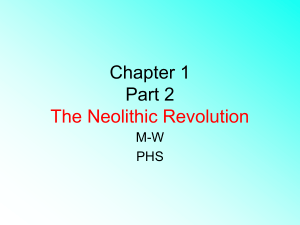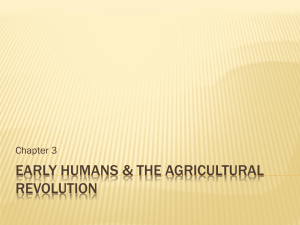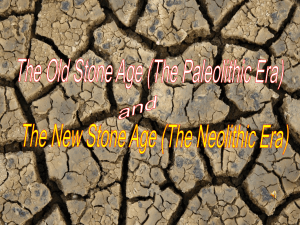Ancient Ireland - Portlaoise College
advertisement

Ancient Ireland • • • • The Mesolithic Stone Age The Neolithic Stone Age The Bronze Age The Celts Ancient Ireland Mesolithic Stone Age 7000 BC Neolithic ? Stone Age 4000 BC Bronze Age 2000 BC Iron?Age Celts 500 BC Mesolithic Stone Age • • • • • Axes Spears and Harpoons Scrapers Bone Needles First people in Ireland 8000 BC Tools and weapons made of stone Hunter gatherers Ate berries, nuts, fish, wild pig, deer and other animals • Mount Sandal, River Bann Northern Ireland Neolithic Stone Age • Means ‘New Stone’ Age – they still made weapons and tools from stone • 4000 BC: First farmers Changes Sharper polished stone tools They introduced pottery, farming, ploughs, barley and wheat, farm animals like sheep, cattle and pigs Built bigger stronger houses made of wattle and daub walls and thatched roofs Megaliths Neolithic farmers brought pottery to Ireland. • They used stones to grind the wheat for bread Look at the houses on page 21 • Usually rectangular. • thatched roofs made of straw. • A hole in the roof was a chimney for fires, lit on a stone in the middle of the floor. • They drove timber posts into the ground and held them in place with rocks. • They made walls out of ‘wattle’ and ‘daub’. • Wattle was made by weaving twigs and branches through sticks (like basket making) • Daub is a mixture of mud and straw which was ‘daubed’ on the wattle. • Wattle and daub made the houses warmer and less drafty. First Farmers: Sites Because the ‘Neolithic Farmers A. Settled in one place B. Had a reliable food supply they were able to form communities and work together, for example: C. They were able to build bigger structures: megaliths D. Megaliths prove they believed in life after death Sites where neolithic farmers lived 1. Lough Gur, County Limerick, 2. The Ceide Fields, County Mayo, Court Cairn, Creevykeel, Co Sligo Court Cairns consist of: 1. A semi-circular ‘Court’ at the front where bodies were cremated. 2. An entrance way made of two upright stones and a capstone. 3. A ‘Passage’ leading to the burial chamber 4. A Chamber where cremated remains were placed 5. A cairn, a mound of smaller stones placed over the structure. Creevkeel, Co Sligo Court Cairn Poulnabrone Dolmen, the Burren, Co Clare • Dolmens are stone age tombs • Cremated remains, human bones, pottery and weapons have been found in Dolmens. • Poulnabrone Dolmen on the Burren in Co Clare was used for 500 years to bury the dead. Capstone Portals Passage Graves • A long passage leads to a chamber deep inside • The walls of the passage are made of large upright slabs • The roof is corbelled and covered with an earth mound • Examples are Newgrange, Dowth and Knowth • Newgrange is a case study Newgrange: Case Study • • • • • 4500 years old: oldest building in Europe Long passage leads to a chamber. The roof is corbelled Stones are decorated with spirals The light box over the entrance is positioned so that sunlight lights the inner chamber on the shortest day of the year • They knew a great deal about the sun. • They were skilled builders After Excavation Neolithic Settlements • Lough Gur, Co Limerick • Circular houses with wattle and daub wall and thatched roofs • Post holes • Ceide Fields, Co Mayo • Sewed wheat and barley • Ground the grain with a rotary quern • Kept cows, sheep and goats in stone walled fields The Bronze Age What’s new? • Bronze to make weapons and tools • New jewelry: torcs and lunalae • Fulacht fia • Individual graves: 1. Cist Graves 2. Wedge Graves 3. Standing Stones How Bronze objects were made • Rock containing copper was broken and smelted over a fire • Smelted copper (from Killarney) and tin (from Cornwall, England) were mixes and poured into a mould • Bronze axes, arrowheads, spear heads, and the first swords Bronze Age Jewelry was made by smiths: a new craft to Ireland Lunala: thin and moon shaped Torc: gold twisted into bracelets and necklaces Fulacth Fia • Fulacht fia was an ancient cooking place • Dug near a river, so it would fill with water • Lined with stone slabs • Rocks are heated in a fire and put in the water to boil it • Cooked meat wrapped in straw Bronze Age Graves • 1. Cist Grave • Carnmore, Co Louth • Rectangular pit lined with stone slabs • Person buried in crouched position with grave goods such as food and weapons • Wedge Tombs • Lisdoonvarna, Co Clare • Shaped like a wedge of cheese • Standing Stones • Drombeg, Co Cork • Might have been a type of calendar Wedge Tomb Mesolithic Stone Age Neolithic Stone Age Bronze Age 8000 BC Hunter Gatherers Hut-like houses Weapons and tools made of stone Mount Sandal 4000 BC First Farmers Wattle and daub houses Pottery, wheat and barley Pigs, sheep and cattle Megaliths Dolmens (Poulnabrone) Court Cairns(Creevkeel) Passage Graves (Newgrange) Ceide Fields Lough Gur 2000 BC Weapons and tools made of bronze Torc & Lunala Smelting and moulds First smiths First swords Fulacht fia / rotary querns Individual graves Cist Graves (Carnmore, Co Louth) Wedge Tombs (Lisdoonvarna, Co Clare) Standing Stones








